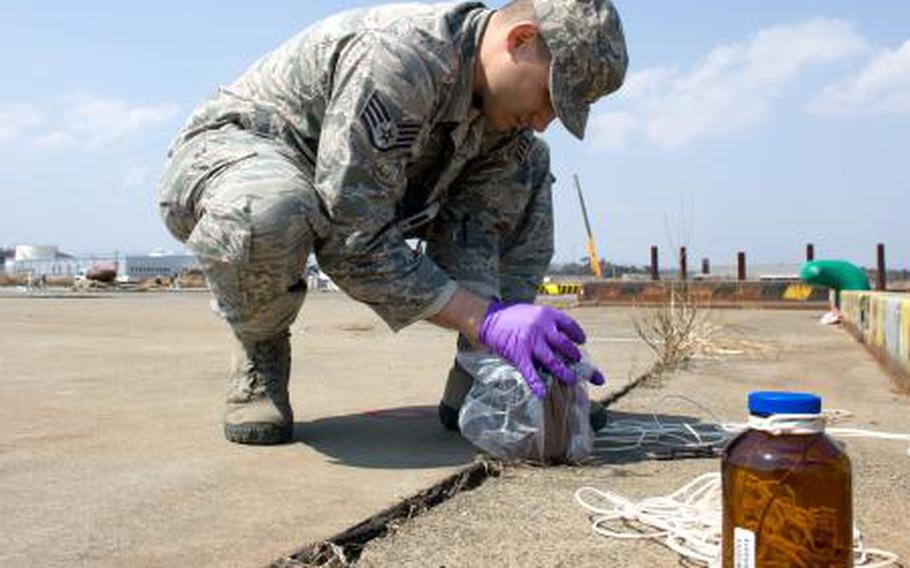
Staff Sgt. Kevin Rivera, Air Force Radiation Assessment Team, collects seawater sample at Onahama port, Fukushima prefecture, March 29. (Yasuo Osakabe/U.S. Air Force)
SASEBO NAVAL BASE, Japan — It’s been two years since the Great East Japan Earthquake, tsunami and nuclear disaster, and the Japanese government has yet to dispose of the backlog of radiated waste left over from recovery and cleanup efforts — including that being kept at U.S. bases in Japan.
The irradiated rags, filters, wipes, aircraft and ship parts, as well as personal protective equipment being stored at U.S. bases in Sasebo, Misawa, Yokota, Yokosuka, Atsugi, and Futenma — and Japanese Self-Defense Force bases in Yokosuka, Iwakuni and Hyakuri — have very little radiation and thus are a low priority, given there are 87,884 tons of more highly irradiated rubble and materials still in need of disposal.
There is no plan or timetable for disposal of any of the materials, but discussions are ongoing, Japanese officials said.
“We are currently considering [the process] with the ministries concerned,” a Tokyo Electric Power Company spokesman told Stars and Stripes. TEPCO is the nationalized utility responsible for the Fukushima Dai-ichi nuclear plant that spewed radiation into the atmosphere and sea after it was nearly destroyed by the tsunami. “We will take measures under the direction of the ministries.”
The spokesman, who spoke on the Japanese customary condition of anonymity, declined to elaborate on why the process was taking so long.
Officials from U.S. Forces Japan said they would continue to hold on to the waste and wait for the Japanese government to pick it up for disposal. They said servicemembers at their facilities are trained to safely handle the materials.
“The waste we are talking about is very low level and poses no threat or health hazard to the public,” officials from U.S. Forces Japan said in a statement to Stars and Stripes. “U.S. officials have good confidence that the low-level radiated waste at U.S. military installations is safely stored and does not pose any health risk… We will continue to closely coordinate with the Government of Japan on the issue, as they work to develop a plan to ensure the waste is disposed of properly in accordance with their laws.”
After the tsunami, which claimed the lives of more than 15,000 people, Japanese Self-Defense Forces and their American counterparts stepped in to perform search-and-rescue and aid distribution missions. The mission quickly evolved into cleanup and rebuilding.
In the months following the disaster, American and Japanese forces were asked to store the low-level irradiated waste at their bases until the Japanese government could dispose of the materials. News of the storage plan led to an uproar from local officials, who have now become pacified by the eventuality that there is simply too much contaminated waste to get rid of expeditiously.
“Operation Tomodachi helped us greatly and the waste was generated as the result of the operation,” said Asao Maki, Sasebo city assembly member and vice-chairman of the base affairs committee. “I am thankful that the U.S. military is storing it safely.”
Maki said he is not concerned because the materials are kept safely by the U.S. military, but he still hoped the Japanese government would dispose of the waste soon. He said calls complaining about its storage have slowly trickled to a stop over time.
This is a far cry from 18 months ago when the assembly sent a letter to various government officials — including the foreign minister and the prime minister at the time — demanding that the materials be disposed of immediately citing concerned residents.
“It is extremely important for us to eliminate the anxiety of the residents, who also have very high interests in this matter,” the statement read. “Sasebo City Assembly therefore demands the government to further disclose information along with securing safety by closely monitoring the radioactive waste, and most of all, take necessary measures to enact legislation to decide on a method of disposal and to dispose them as soon as possible.”
A spokeswoman from the Status of Forces Agreement Division at the Ministry of Foreign Affairs said the storage standards by both militaries are high and the waste is kept in containers in a safe place. These areas are periodically monitored for radiation.
Japanese government officials declined to comment on plans for the 87,884 tons of radiated rubble and materials with a higher concentration. This figure does not include low-level radiated waste found off-base, as the government of Japan doesn’t track it, an official from Japan’s Ministry of the Environment said. It also does not include waste that has not been reported to the government.
Stars and Stripes’ Elena Sugiyama contributed to this report.